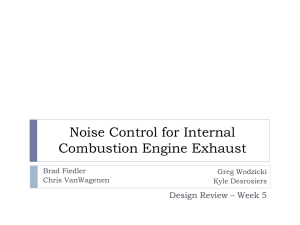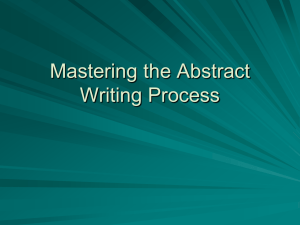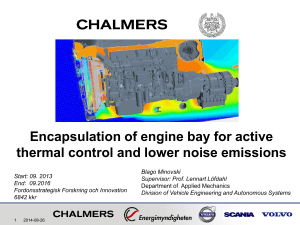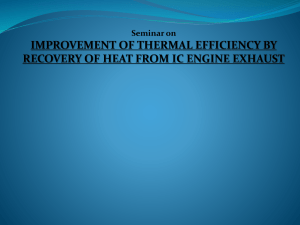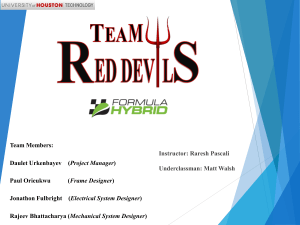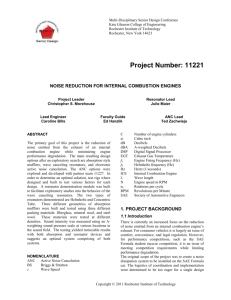Adaptive Active Noise Control for Internal Combustion Engine
advertisement
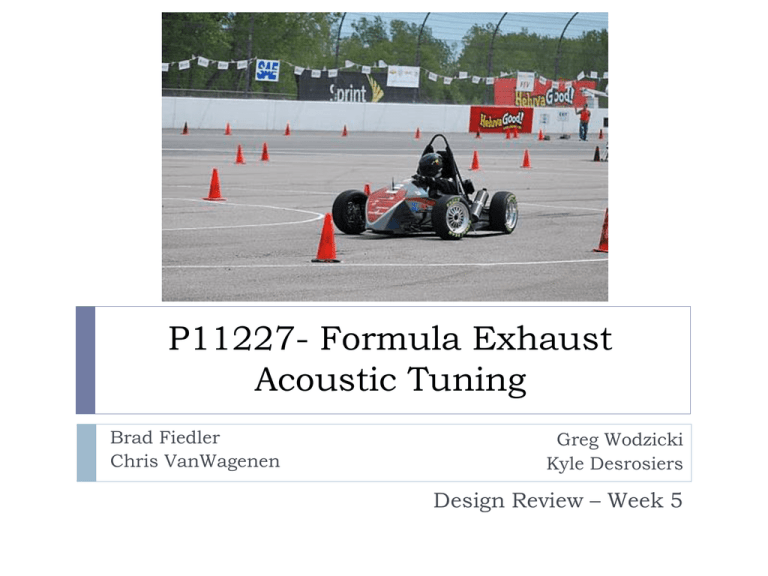
P11227- Formula Exhaust Acoustic Tuning Brad Fiedler Chris VanWagenen Greg Wodzicki Kyle Desrosiers Design Review – Week 5 Agenda Introduction / Background Problem Statement Customer Needs Engineering Specs Understanding the Problem and Current Technology Concept Review Test Bench Closing Questions Problem Statement Formula SAE rules state exhaust noise volume must be lower than 110 dB before allowing a team’s car to compete. Any vehicle that does not pass may be modified and retested until it passes. Current muffler design is glass pack, which is often repacked at competition to lower the noise level within spec. The purpose of this project is to provide the RIT Formula team with means to lower their exhaust noise consistently and more predictably. Introduction / Background Problem Background FSAE rules dictate engine noise under 110dB. Current Passive Noise Control device does not involve extensive design. Packing material deteriorates over usage time and noise attenuation decreases throughout season. Introduction / Background Current Glass Pack Design Not currently heavily designed area of car Packed/repacked onsite at competition to pass Summer 2010 scored ~102 dB at competition Life: ½ season before glass melts and attenuation becomes less affective Used as reference for concepts explored Source: P11221 Introduction / Background Original Design Objectives Design system to cancel sound output without sacrificing performance to: Bring Engine sound under FSAE limit of 110dB. Adhere to all FSAE Rules To not add Significant weight to Vehicle Maintain/Improve engine performance Introduction / Background Customer needs Customer Need # Importance CN1 9 Reduce the sound level of RIT's Formula SAE engine to meet the legal formula level CN2 9 Be able to demonstrate RIT's Formula Car will pass FSAE Sound Regulations CN3 3 Prove concept of sound acoustics (i.e. attenuation, freq shift, etc) CN4 1 Obtain needed understanding of acoustics and sound waves CN5 1 Obtain needed understanding of Engine Characteristics (i.e. firing freq, Sound characteristics, torque power) CN6 1 Analyze data and identify optimal areas of improvement CN8 9 Maintain Engine Performance (torque, horsepower) CN9 9 Maintain Vehicle Performance (weight, battery reserve, size, Vibration) CN10 3 Demonstrate feasibility of active noise cancellation on IC Engine (Test Stand) CN11 3 Understand the fundamental sources of noise generation from the normal operation of an IC Engine. (1. Discrete frequency sources, 2. broad band or white noise sources) CN12 3 Propose noise reduction methods for each source CN13 9 Easily fixed during competition (if breaks) CN14 1 Lower center of gravity by location of exhaust system CN15 3 Resilience of design (lasts at least half a season) Description Comments/Status Engineering specs Engineering Specifications Specification (Description) Unit of Marginal Ideal Measure Value Value dBA ES # Importance ES 1 9 Reduce noise level ES 2 9 Maximum length extending from rear axle in 17.6 17.7 SAE Rules ES 3 9 Maximum distance above the ground in 23.5 23.6 SAE Rules ES 4 9 Passes B10.3 of the SAE Formula rules dBA, fast weighting 110 <110 SAE Rules ES 5 ES 6 ES 7 3 1 3 System Power Draw System Life Component Costs Watts hours $ Comments/Status Cheap as possible 3 Discuss with SAE team ES 8 1 Exhaust Envelope (volume of space) ft ES 9 9 Internal Exhaust Components Survivable Temp °F Discuss with SAE team ES 10 9 psia Discuss with SAE team ES 11 3 Internal Exhaust Components Survivable Pressure Component Shock Threshold ES 12 3 Change in Engine Max Power HP 0 ES 13 1 Weight limit on exhaust system lbs 8 ES 14 3 Maximum allowed back pressure psi g Discuss with SAE team Change in power must be justified by significant improvement elsewhere Approximately equal to current Define from analytical data/literature research Person Understanding the Problem Sound Waves (see Figure 1) Superposition Human Auditory Range (frequency) Harmonics Four-stroke engine (see Figure 2) Cycles: intake, compression, power, exhaust Noise Sources “Chatter” Intake Exhaust- Main source Firing Frequency (See Fig 3) Glass Pack Exhaust Travels through Pipe with Perforated Holes Sound Insulation Absorbs Sound Minimal Back Pressure Least Effective in Reducing Sound Concepts Multi-pass Muffler Concepts No Baffles Exhaust Forced to turn back and forth Increases Exhaust Length Increased Back Pressure with each turn Sound Insulation Absorbs Sound Moderately Effective in Reducing Sound Baffle Muffler Reflects Exhaust Throughout Chamber Reflections Cancel each other Most Back Pressure created Greatest Sound Reduction Concepts Elimination of Baffle and Multi-Pass Pros: Multi-pass provides better attenuation than glass pack. Baffle (chamber style) muffler provides even better attenuation than multi-pass. Cons: Multi-pass increases exhaust back pressure Baffle style will cause the most back pressure of all the design concepts. Baffle and multi-pass are quieter, but increase backpressure. It has already been seen that Glass Pack can achieve FSAE limit with lower backpressure Concepts Variable Length Resonator Engine • • • • Traditional Resonators are tuned to address particular range of frequencies Generally target the most problematic (loudest) frequencies As engine speed changes, exhaust frequencies change Variable length resonator addresses wider range of frequencies Cons: • Adds weight • Waves reflect in accordion (baffles) • FSAE states system must be tested in all positions. If not at the ideal position for a given frequency, the resonator will do nothing to attenuate sound Parallel ANC with Microphone and Feedback Courses of Action Multiple Speaker with Error Microphone Courses of Action Exhaust in Speaker Chamber Performance Objective Possible Performance Effects of Active Noise Cancellation Technology: A – No Exhaust Tuning B – Traditional Exhaust Length Tuning C – Possible Active Noise Cancellation Improvement* * Dependent on cancellation method Introduction / Background Risk Assessment Risk # Description of Risk Possible Consequences Overall Risk (81 = high) Preventative Measures Contingency Plan 1 FSAE Engine is occupied or nonfunctional Lack of data from formula car 9 Constant communication with RIT Test exclusively on lawn mower engine Formula team (Taylor Hattori) 2 Microphone not functional Can not record engine waveform 9 Keep in safe place, handle with care, use appropriately 3 Lawn mower engine failure Can not record engine waveform, can not test designs 27 Check oil level before each use, Use backup engine otherwise maintain engine properly 4 Non-ideal testing conditions (rain, noisy, etc) Equipment ruined, testing delayed 27 Keep an eye on weather conditions Reschedule Testing 5 Lack of budget Design not able to be created spring quarter 27 Ensure each aspect of the design is Borrow parts, see what is available from designed as cost effectively as various labs possible 6 None of the muffler designs reduce sound within the target range Project fails 9 Use best available, most feasible design Explain why designs did not work as expected. 7 Materials/mufflers are destroyed/ruined during testing. Sound absorption of design is reduced. 27 Purchase excess material, incorporate factor of safety into designs Purchase excess material. Introduction / Background New Microphone 8 Lack of scientific knowledge surrounding signal processing Deliverables missed, sound not attenuated 9 Use simple components and Find expert to assist in signal software that we have existing processing. Simplify design by knowledge of or can readily learn removing some components. 9 Engine noise (non-exhaust) is not negligible for lawnmower engine. Sound reading not accurate. 9 Make sure measuring sound according to SAE rules. 10 ANC muffler actually creates ANC design is improperly calibrated more sound rather than attenuates sound. 81 Have a system that is able to be Re-calibrate and try again. modified and recalibrated. 11 Deviation from project timeline. 9 Allot appropriate time for each task 12 Exhaust system design might Oversimplified or bad assumptions be incorrect and need to be lead to incorrect data. modified 9 Double-check all assumptions Exhaust design would have to be with subject matter expert, test modified to accommodate assumption with data collection. misconceptions. 13 Equipment doesn’t exist that can Design not able to be built in survive in the conditions around the SD2 engine 81 Go through each aspect of the design, keeping in mind survivability conditions. Change materials or geometry. 14 Customer needs change 3 Constant communication with RIT Formula team (Taylor Hattori) Change the project plan to accommodate changes and discuss feasibility of changes with customer Fall behind on project objectives Project plan no longer completes customer needs by the end of senior design. Insulate engine "chatter" from microphone Simplify and re-prioritize tasks. Concept Screening A B C D E F ANC1 G ANC2 H ANC3 Selection Criteria Glass pack Modified Glass pack Multlipass Baffle muffler Variable length resonator Speaker parallel to exhaust Multiple speakers Exhaust in speaker chamber Ease of manufacture Noise reduction Weight Ease of field repair Costs Effect on back pressure Center of gravity Size Power usage Survivability Sum + 's Sum 0's Sum -'s Net Score 0 0 0 0 0 0 0 0 0 0 0 10 0 0 0 + + 0 0 0 0 0 0 2 7 1 1 + 0 0 0 0 1 4 5 -4 + 0 0 0 0 1 4 5 -4 + 0 0 0 0 1 4 5 -4 0 0 + + + 3 2 5 -2 0 + + + 3 1 6 -3 + 0 + 0 0 0 2 4 4 -2 Rank 2 1 6 6 6 3 5 3 Y N N N Y N Y Continue? Concept Screening (cont’d) A Glass pack Selection Criteria Rating Wtd Ease of manufacture Noise reduction Weight Ease of field repair Costs Effect on back pressure Center of gravity Size Power usage Survivability Rank Rating Wtd C Multipass Rating Wtd D Baffle Muffler E Variable length resonator F Speaker Parallel to exhaust G Multiple Speakers H Exhaust in speaker chamber Rating Wtd Rating Wtd Rating Wtd Rating Wtd Rating Wtd 0 0.00 0 0.00 -1 -0.07 -1 -0.07 -1 -0.07 -3 -0.20 -3 -0.20 -9 -0.61 0 0.00 1 0.20 3 0.61 9 1.84 3 0.61 1 0.20 3 0.61 3 0.61 0 0.00 1 0.20 -1 -0.20 0 0.00 -1 -0.20 0 0.00 -3 -0.61 0 0.00 0 0.00 0 0.00 -1 -0.07 -1 -0.07 -3 -0.20 -3 -0.20 -3 -0.20 -3 -0.20 0 0.00 -1 -0.07 -1 -0.07 -3 -0.20 -3 -0.20 -3 -0.20 -9 -0.61 -3 -0.20 0 0.00 1 0.20 -3 -0.61 -9 -1.84 0 0.00 3 0.61 3 0.61 3 0.61 0 0.00 0 0.00 0 0.00 0 0.00 0 0.00 3 0.07 3 0.07 3 0.07 0 0.00 -1 -0.02 -1 -0.02 -3 -0.07 -1 -0.02 3 0.07 9 0.20 0 0.00 0 0.00 0 0 0.00 0 -3 -0.20 -9 -0.61 -3 -0.20 0.00 0 0.00 -1 -3 -0.20 -3 -0.20 -1 0 Total Score B Modified Glass Pack 0 0.00 0 0.00 0 -0.07 -0.07 0.00 0.52 -0.43 -0.41 -0.16 -0.07 -0.95 0.00 2 1 7 6 5 4 8 2 Proposed Design Objective Test Bench that can be used as a tool by the formula team to facilitate muffler design and evaluate possible solutions prior to competition Characteristics to be analyzed may include: Pressure drop across muffler Flow rate (volumetric, mass flow rate) Sound level output Waveform data Test Bench
